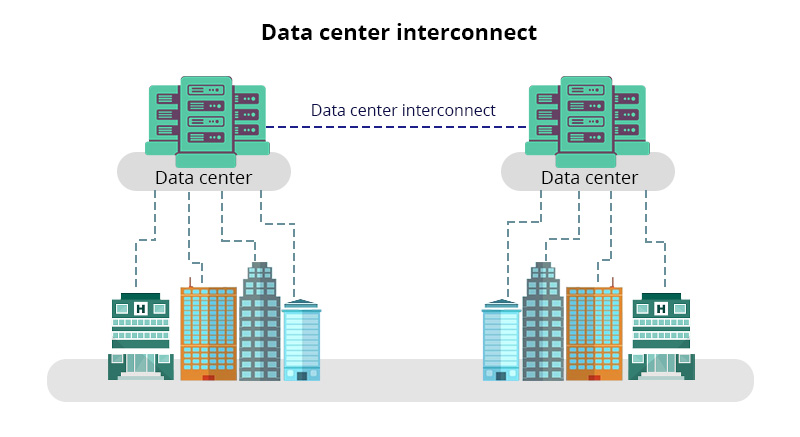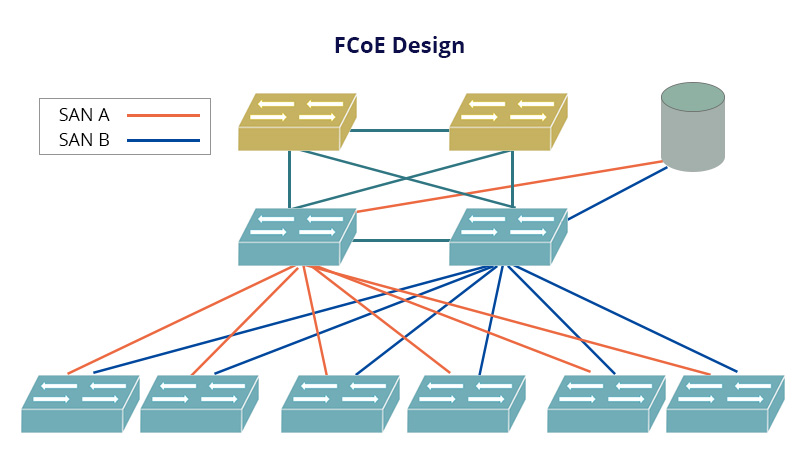Everything You Need to Know About Data Center Interconnect (DCI)
Data centers are experiencing exponential growth, with over 7,500 establishments worldwide. This surge suggests that your business likely owns or is connected to one or more data centers. However, these facilities are not isolated entities but interconnected using Data Center Interconnect (DCI) technology.
What is Data Center Interconnect?
Data Center Interconnect (DCI) technology facilitates the connection of two or more data centers over varying distances through high-speed packet-optical connectivity. These data centers are repositories for computing and storage resources handling applications, data, and content. In today's cloud-centric and application-driven landscape, ensuring seamless access to this data is imperative.
Data Centers need to communicate with one another to exchange data, share content, and ensure redundancy through backups. Thankfully, DCI technology facilitates the seamless transfer of essential assets across various distances, from local connections to extensive trans-Pacific or trans-Atlantic links. These data transmissions can occur via straightforward point-to-point connections, resilient ROADM-based networks, or open line systems that accommodate transport interfaces from multiple vendors.
Large enterprises employ DCI technology to interconnect their internal data centers within their extensive enterprise infrastructures. Conversely, others connect with partners, cloud providers, or data center operators to streamline data and resource sharing or facilitate disaster recovery processes. Furthermore, subsea cables serve as crucial conduits, linking data centers and internet exchanges across countries and continents, even when separated by vast oceans.
Data Center Interconnect empowers enterprises to establish a unified, interconnected infrastructure supporting their vital applications and services. This technology facilitates the smooth transfer of data, workloads, and resources among data centers, guaranteeing optimal performance, scalability, and flexibility. Through seamless interconnection, businesses can attain heightened availability, enhanced data replication, and streamlined management of their distributed infrastructure.

Compare The Three Types of Data Center Interconnect Solutions
LAN Extension: It facilitates the creation of a unified Layer 2 domain spanning multiple data centers. This is particularly beneficial for data center applications that rely on legacy systems or employ embedded IP addressing, necessitating the expansion of Layer 2 connectivity across different data centers. The Layer 2 Extension feature offers a seamless method for distributing the necessary physical resources, catering to application frameworks that require dynamic mobility of active machines, whether they are virtual or physical.
Layer 3 Extension: It offers routed connectivity between data centers, serving purposes such as segmentation, virtualization, and facilitating file server backup applications. This connectivity typically involves utilizing Layer 3 VPN-based solutions, necessitating careful consideration of bandwidth allocation and Quality of Service (QoS) parameters.
SAN Extension: It poses unique challenges and considerations due to specific requirements concerning distance, latency, and the inherent inability to transport Fibre Channels directly over an IP network. These challenges necessitate specialized solutions and careful planning to ensure seamless SAN extension while effectively addressing distance and latency constraints.
Apart from the 3 functional components mentioned earlier, a comprehensive Data Center Interconnect (DCI) solution typically incorporates a building block called Path Optimization. This aspect addresses the complexities arising when a specific VLAN (or subnet) is extended across geographically distant locations. Special considerations must be considered for routing paths between client devices accessing application servers on these subnets and for server-to-server communication, particularly in multi-tier application setups. Path Optimization encompasses various technologies aimed at optimizing communication paths in these scenarios. Furthermore, integrating network services such as firewalls and load balancers is a crucial design aspect of a DCI solution, given the challenges associated with maintaining access to stateful services while relocating workloads between data center sites. LAN Extension, highlighted earlier, remains a pivotal component of a robust DCI infrastructure.
The Main Data Center Interconnect Technologies
DCI technologies present businesses with a range of versatile and reliable connectivity options. Three standout technologies, widely adopted for their effectiveness, are Fibre Channel over Ethernet (FCoE), Virtual Private LAN Service (VPLS), and Multiprotocol Label Switching (MPLS). These technologies offer distinct advantages tailored to various network needs and scenarios.
Fibre Channel over Ethernet (FCoE)
FCoE is a technology that merges Fibre Channel and Ethernet networks, facilitating the transportation of Fibre Channel traffic over Ethernet networks. This convergence enables data and storage networking to consolidate, which proves invaluable in Data Center Interconnect (DCI) scenarios. FCoE seamlessly integrates storage area networks with existing Ethernet infrastructures, simplifying network management and reducing operational costs associated with maintaining separate networks. This technology benefits organizations aiming to streamline their data center operations by unifying data and storage connectivity on a single network infrastructure.

Virtual Private LAN Service (VPLS)
VPLS operates at Layer 2 and extends LAN connectivity over wide area networks (WANs). Leveraging MPLS technology, VPLS connects diverse sites across metropolitan or wide area Ethernet networks, effectively creating the illusion of a unified local network. This service provides remarkable flexibility, enabling businesses to establish a seamless, scalable, and secure Ethernet-based network that interconnects multiple locations. VPLS proves especially advantageous for companies with geographically dispersed data centers, necessitating robust data synchronization and real-time data replication capabilities.
Multiprotocol Label Switching (MPLS)
MPLS is a routing technique that operates independently of specific protocols intended to enhance the speed and management of traffic across expansive enterprise networks and service provider infrastructures. By utilizing concise path labels rather than lengthy network addresses, MPLS efficiently directs data from one node to another, eliminating the need for intricate lookups in routing tables and accelerating traffic flow. In the Data Center Interconnect (DCI) context, MPLS plays a pivotal role in establishing virtual private networks, ensuring secure and efficient data transport between diverse data center locations.

What are the Key Challenges of DCI Networks?
Distance: The scale and geographical spread of Data Center Interconnect (DCI) applications can vary significantly. Data centers might be within a metropolitan area, across a country, or even globally distributed. It is essential to have sufficient performance to interconnect these data centers efficiently while maximizing data transmission over long distances. Utilizing performance-optimized coherent technology is crucial in achieving this goal, as it allows for the transportation of greater capacity over any distance. These technologies offer programmable interfaces with selectable baud rates and various modulation schemes, enabling fine-tuning capacity to suit different applications' requirements.
Capacity: Data centers play a crucial role in storing and delivering the data needed by various applications. Addressing the growing bandwidth demands becomes imperative as routers transition from 100GbE to faster 400GbE services. QSFPTEK's QT900-CH2U08 chassis is designed to support large-capacity transmission, a maximum capacity of 8x400G, which is up to 3.2TGbit/s, effectively meeting these evolving requirements and ensuring reliable, high-capacity connections.
Security: Security is paramount in data center operations where sensitive information, such as financial transactions, personnel records, and corporate data, is frequently stored. Given this data's critical nature and high confidentiality, Data Center Interconnect (DCI) systems must prioritize reliability, safety, and encryption to prevent costly breaches and data loss.
Operations: Efficient operations are crucial for minimizing labor, complexity, delays, and errors associated with manual tasks such as commissioning, provisioning, and managing Data Center Interconnect (DCI) networks. Optical networking platforms designed explicitly for DCI applications offer management through open interfaces or Zero Touch Provisioning(ZTP) and comprehensive lifecycle management software platforms. These solutions provide network operators the flexibility to manage the DCI infrastructure effectively.
What Can You Achieve with a DCI Connectivity System?
Robust Performance
Data Center Interconnect (DCI) facilitates quicker and more dependable data transmission among data centers, a critical aspect for applications that demand real-time data access and processing. Through high-speed connectivity and minimized latency, DCI elevates the overall performance of networked applications, resulting in enhanced user satisfaction and operational effectiveness.
Disaster Recovery and Business Continuity
Linking multiple data centers enables organizations to replicate data and applications across diverse geographical locations. This guarantees that essential operations can seamlessly transition to another site should a disaster or system failure occur at one site, thus minimizing downtime and data loss.
Scalability and Flexibility
As organizations expand, their data needs typically grow as well. DCI offers the scalability required to increase IT resources smoothly and without significant disruptions. Businesses can effortlessly incorporate new data centers into the network or enhance the capacity of existing connections.
Enhanced Security
With DCI, organizations can enforce consistent security policies across all interconnected data centers, bolstering overall data security. Advanced encryption techniques and secure transmission protocols within DCI architectures ensure that data remains safeguarded during transit.
Cost Saved
Interconnecting data centers enables organizations to optimize resource utilization and drive cost efficiencies. For instance, data centers in different regions can share resources like storage and processing power, leading to more effective use of IT infrastructure. Furthermore, DCI reduces the necessity for physical infrastructure by enabling organizations to leverage shared or cloud-based resources, resulting in decreased capital and operational expenses.
Conclusion
Most companies' business revolves around information—it needs to be securely stored, protected, and readily accessible. The data center interconnect is vital in facilitating access to cloud applications and services and enhancing user and customer experiences. DCI solutions are instrumental in achieving these objectives while improving efficiency and reducing costs. QSFPTEK offers a diverse range of data center interconnection solutions, catering to various distances and configurations. Feel free to consult our technical team for a comprehensive product list. Whether you're transmitting data within the same campus or across distant continents, we have the appropriate detailed solutions to meet your requirements.










